Fulfilling potential: building a technological framework for unmanned aircraft to safely use national airspace

Summary: Our researchers are testing new technologies that will ultimately enable Beyond Visual Line of Sight operations of unmanned aircraft, enabling them to reach their immense potential.
Status: Ongoing
Key staff: Professor James P Scanlan, Andy Keane, Dr András Sóbester, Dr Mario Ferraro, Dr Mehmet Ali Erbil
Explore this case study:
The challenge
There is huge potential for the use of autonomous aircraft systems across a range of scientific observation missions, as well as in roles where they aid disaster response or help monitor, operate and maintain our infrastructure.
Some of these missions have traditionally been performed by manned aircraft, often at great cost, or by exposing pilots to hazardous environments. Other missions are completely new: unmanned aircraft can perform previously impossible tasks, such as large-scale environmental observation, or the penetration of highly contaminated or very confined environments, such as the aftermath of a nuclear disaster.
However, unmanned air vehicles will only fulfil their immense potential if we can build the technological framework that allows their safe integration into the national airspace.
Our challenge is to uncover and better understand the technological and operational advances that allow routine, extensive and safe use of unmanned aircraft in the national airspace.
What we did
Currently, unmanned aircraft flight is limited either to segregated, special blocks of airspace or to operations within visual line of sight of the pilot. There are additional restrictions in terms of operating aircraft in densely populated environments.
The aim of our collaborative research project, AIRSTART (Accelerated Integration of Reliable Small UAV systems Through Applied Research and Testing), is to set up the technological framework required before ‘Beyond Visual Line of Sight’ (BVLoS) operations become routine.
The AIRSTART route to advancing BVLoS uses enhanced mission management and collision avoidance capabilities. A key technology being explored by our research team is the use of lasers to pinpoint the exact location of the aircraft in flight and to provide high speed data links for secure and robust communications between the ground station and the vehicle.
Our impact
AIRSTART flight testing is currently underway, using the SPOTTER platform, developed by our University of Southampton research team. SPOTTER is a twin-engined platform with a maximum take-off weight of 35kg, which allows flight tests with experimental payloads of up to 5kg.
Our researchers are also involved in EVLOS (Extended Visual Line of Sight) experiments, most notably as part of Project Albatross. Albatross saw the deployment of SULSA (Southampton University Laser Sintered Aircraft – the world's first 3d-printed aircraft) in Antarctica in operations designed to demonstrate its Extended Visual Line of Sight flight capabilities and increase the situational awareness of the Royal Navy's ice patrol ship HMS Protector.
The facilities we used
We used the following facilities within the University - Autonomous Aircraft Field Operations Support Vehicles
Find out more about the Engineering and Environment Faculty's many world class facilities.
Partners we worked with
We worked on this research with Airbus plc, Royal Navy, EPSRC UK-RAS Network and ASSURE
Related media


Related Staff Member
Related Staff Member
Related staff member
Related Staff Member
Links to external websites
The University cannot accept responsibility for external websites.
Links to external websites
The University cannot accept responsibility for external websites.
Links to external websites
The University cannot accept responsibility for external websites.
Other University of Southampton sites
You might also be interested in
Computational engineering and design group
Discover more about our research group, dedicated to carrying out multidisciplinary research using a range of analytical, computational and experimental techniques.
Other robotics and autonomous sytems case studies
Learn more about the research we are undertaking in these areas.
Postgraduate opportunities
Explore our postgraduate research degrees.
Media enquiries
Make a media enquiry about this case study



